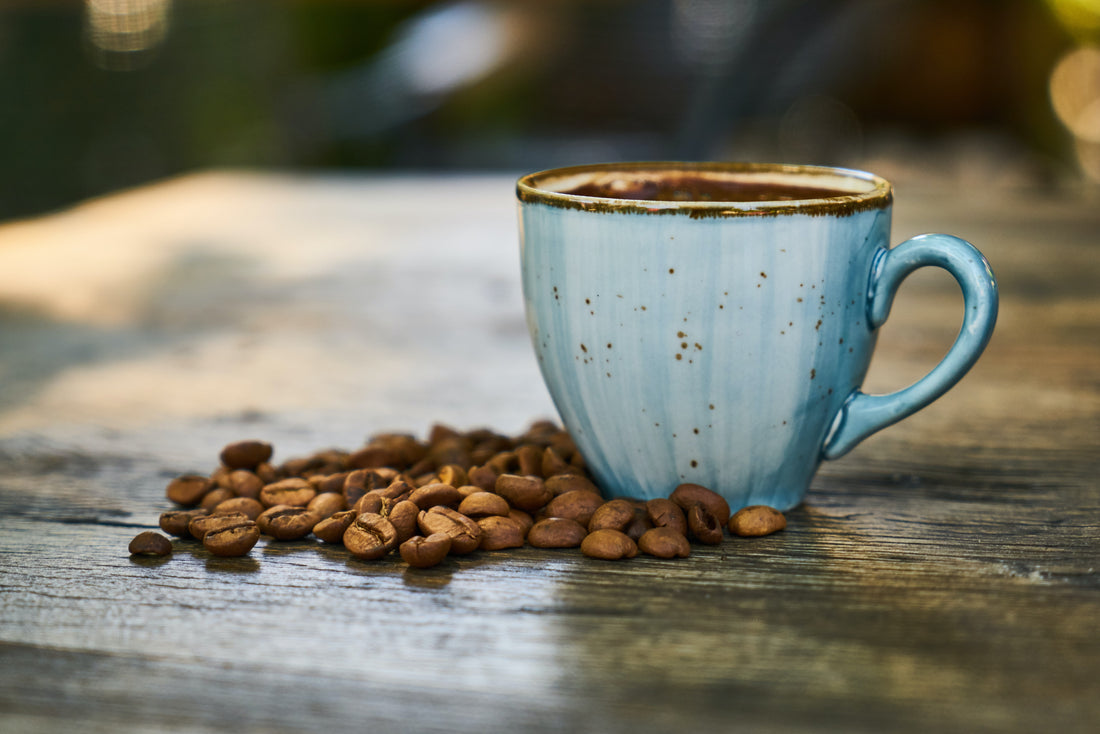Sometimes you want the taste and experience of coffee without the caffeine hit. People may choose to drink decaffeinated coffee for different reasons, but not all decaf is created equal. In this article, we will look at how decaf coffee is made, and what it is that makes Swiss Water Process decaf coffee the best option for your decaf coffee needs.
What is decaf coffee?
Decaffeinated coffee, or “decaf”, has been around longer than you might think. Decaf coffee first became commercially available in the very early 20th century, after a shipment of coffee accidentally fell into the sea. Once recovered, it was observed that the beans lost their caffeine concentration without much difference in taste - albeit a touch saltier.
Caffeine is a naturally occurring substance found in certain plants, specifically the ones that we get coffee, tea and chocolate from. Its main purpose is to help the plants defend themselves from bugs and other predators, but in humans, it acts as a mild stimulant. The amount of caffeine found in coffee depends largely on the type of beans chosen as well as the brewing process employed.
Robusta for instance can contain nearly twice the amount of caffeine as Arabica beans, with light-roast blends tending to be the strongest. This is not to mention the dose used and how long it is brewed for, all of which can have an impact on the amount of caffeine that ends up in your cup.
A single shot of generic espresso will come in at about 40mg of caffeine, whereas a longer brewed, stronger cup of drip coffee can come in at 200mg+ per cup.
Much like “alcohol-free beer”, however, decaf does not mean caffeine-free: there will still usually be between 0.2-5mg of caffeine present per serving, depending on the decaffeinating method used.
Why do people drink decaf?
A recent study showed that 68% of people think they need to cut their caffeine intake, which when you consider that coffee is the second most popular beverage in the world, means a huge trend towards decaf coffee. This is borne out in research, with consumption of decaffeinated coffee on the rise, especially among younger people.
Caffeine sensitivity varies from person to person. Factors such as body weight, the type of food consumed and the body's metabolic rate can all play a part in your tolerance levels, and these can change on a day-to-day basis. Someone with a sensitivity to caffeine can feel the effects from as little as 10 mg, meaning even a small caffeinated drink can cause a variety of unwanted symptoms. Some people also have a caffeine intolerance, and must watch not only what they drink, but also the food they eat, with some chocolate bars containing as much caffeine as a small cup of coffee.
As well as its well-known effect on sleep, caffeine can have other negative side effects, particularly as consumption increases. These can include anxiety, headaches, dizziness and irritability, although all of these are only temporary. Some people drink caffeinated drinks in the morning for their jolt, then switch to decaf in the afternoon to lessen the effect on their sleep patterns.
There are also a host of health reasons that have people opting for decaf: high blood pressure, pregnancy, heart or gastrointestinal issues can all be exacerbated by caffeine, while some medications also don’t interact well with the stimulant.
While the caffeine in coffee can cause health issues, coffee itself can also be good for you. Some people simply want the health benefits that drinking coffee offers - cardiovascular protection, stimulated digestion, and antioxidants, plus the latest research shows that coffee reduces the risks of Parkinsons and Alzheimers - just without the excess energy.
Can you get decaf coffee beans?
Any coffee bean can be decaffeinated, and that is usually how they are bought by coffee shops, as all coffee - decaf or not - tastes best when freshly ground. You can also get pre-ground decaffeinated coffee beans if preferred.
Coffee beans are generally put through decaffeination while still green - in other words, before being roasted. As the decaffeinating process can be quite complex, however - and usually takes place out of house - most companies send their beans to be decaffeinated in large batches.
How is decaf coffee made?
Let’s face it: decaf coffee does not have the best reputation for tasting good. But that doesn't have to be the case. A good quality decaf coffee blend can taste phenomenal, with only true coffee experts being able to tell the difference.
But how is decaf coffee made, and what has given them this reputation? While the actual science of it at a molecular level can get a bit overwhelming, the process is fairly easy to understand.
All processes start with taking the green, unroasted coffee beans and immersing them in water or steam, causing them to swell, and making the caffeine easier to extract.
The difficulty of decaffeinating coffee beans is not in removing the caffeine (it is water-soluble, so relatively easy to extract), but in making sure that the other elements don’t seep out too. The wonderful complexity that makes up the flavour and aroma of coffee is the very thing we want to maintain while trying to extract the caffeine molecules. It is for this reason that another substance is added to the process: a decaffeinating agent. Decaffeinating agents are more selective than water at what they draw out, helping speed up the process and limit the loss of the other components that make up the coffee bean, which can result in a washed-out taste.
The choice of decaffeinating agent can be a cause for concern among coffee drinkers, especially if they are solvent-based. Solvents can be applied directly or indirectly to the beans, and are a common but controversial way of decaffeinating beans - both for their effects on taste and on people’s health. This is why we don’t use chemical decaffeinated coffee, we only use Swiss water decaf.
Ethyl acetate
The more common practice for decaf coffee in Europe, this involves soaking the beans in water and a natural ether commonly found in pears and apples, known as ethyl acetate. The use of this method to draw out caffeine can sometimes leave a fruity aftertaste - not necessarily a bad thing, but not always welcome if you like the pure taste of coffee. The issue with this method arises when it is performed on a massive scale, as this often requires fabricated ethyl acetate, which can be perceived as dangerous.
Methylene chloride
This contentious method is regularly used by coffee shops. as it has the least impact on the flavour of the beans. The beans are soaked or steamed again in water, then coated in methylene chloride to speed up the process, as well as to try and maintain some of the other components that can be lost, such as some sugars and proteins.
The reason why this method is viewed as bad is down to ongoing research into the effects of methylene chloride on the body. Research indicates that it can temporarily slow down the central nervous system, affect hand-to-eye coordination, and according to the World Health Organisation (WHO), may even cause cancer. As a result, methylene chloride has been banned in some countries for different uses. Despite this, it is generally deemed to be safe in the decaffeination process as long as the final product contains no more than 10 ppm, or 0.001%, of residual methylene chloride.
How is Swiss Water Process Decaf coffee made?
The Swiss Water Process was first discovered in the 1930s, unsurprisingly in Switzerland. More surprisingly, the main proponent of the process today is now based in Vancouver, Canada.
Swiss Water Process Decaffeination (sometimes also called Activated Charcoal Decaffeination) uses no solvents. Instead, the procedure combines a unique version of a decaffeinating agent, the GCE (Green Coffee Extract), with activated charcoal filters. The GCE is made up of water that is saturated with coffee components but no caffeine, meaning that any coffee beans that are exposed to it will only lose their caffeine molecules rather than flavour.
The beans generally sit in the water for 8-10 hours, or however long it takes for them to become 99.9% caffeine free. After the process, the GCE is again filtered with activated charcoal to remove the caffeine from the latest beans, and is ready to be used again and again. This results in very little waste, and standards are kept high by constantly monitoring the condition of the GCE water.
Once the beans have been decaffeinated to the goal of 99.9%, they are dried again and bagged, ready to be shipped to the customers or companies that rely on them for great decaf coffee beans, such as The Coffee Bean Shop.
You’ll know if your beans are Swiss Water Processed from the company’s unique label - if there’s no label on the packaging, assume it is not.
Due to the absence of any chemicals, the method is certified as both Kosher and Organic. Check out the Swiss Water Process website for more information on the process, as well as the various other certifications and awards that the company and process have been awarded.
How to use decaf coffee
Decaf coffee beans act the same way as regular coffee beans, and you can treat them as such. The only difference you might find is that the grounds can be somewhat wetter, especially finer types such as those for espresso machines. To combat this, apply a bit less pressure when tamping to avoid longer filter times. The longer you take to filter or brew the coffee, the more bitter it will taste.
Final thoughts: why Swiss decaf is best!
If the manufacturer doesn’t make a statement about how their coffee beans are decaffeinated, it usually means they use a solvent-based process, as it is the cheapest and most widely used.
Here at The Coffee Bean Shop, we only ever sell beans that have been decaffeinated with the Swiss Water Process; we simply will not use any other method. As with all of our coffee beans, we also roast them to order - ensuring you get the highest quality, healthiest, and most awarded coffee possible.

